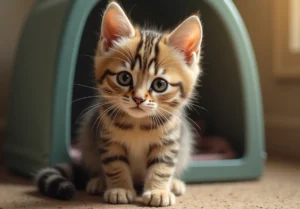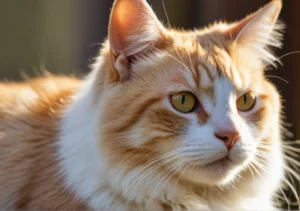Cats are mysterious creatures with many unique traits, including their always cold ears. Have you ever wondered why this is the case? Let’s explore the fascinating reason behind why cats’ ears are always cold.
Anatomy of a Cat’s Ears
Cats have a fascinating anatomy when it comes to their ears, which contributes to why they always feel cold to the touch. Unlike humans, who have straight ear canals, cats have a unique L-shape ear canal that traps air inside. This design helps amplify sounds and enables them to detect even the faintest of noises, a trait leftover from their hunting days in the wild.
Additionally, cats have a large amount of blood vessels near the surface of their ears. This abundance of blood flow is necessary for regulating body temperature, but it also means that when cats are warm, they redirect blood flow away from their ears to cool down. As a result, their ears feel noticeably cooler to us when they are not in need of immediate temperature regulation.
Temperature Regulation in Cats
When it comes to temperature regulation, cats are masters at using their ears to stay cool. Cats lack sweat glands, so they rely on other methods to regulate their body temperature. Their ears play a crucial role in this process by dissipating excess heat. When a cat is feeling warm, the blood vessels in their ears dilate to increase blood flow. The heat from the blood is then released through the skin on their ears, helping them cool down efficiently.
So, contrary to what you might think, cold cat ears are actually a good sign of a healthy and well-regulated body temperature. If your cat’s ears are cold to the touch, it is likely that they are comfortable and content in their environment. Just like how we put on a sweater when we’re cold, cats have their ears to help them stay comfortable.
Remember, a cat’s ears being cold is a natural and beneficial part of their unique anatomy and temperature regulation system.
Fur Coating and Insulation
Let’s talk about why cats’ ears always feel like they’ve just been chilling in a snowbank. Cats, being the furry creatures they are, have a dense coat that helps keep their bodies toasty warm. However, when it comes to their ears, there’s a bit of a design flaw. While the rest of the cat’s body is snug as a bug in a rug, their ears don’t have the same level of insulation. This lack of fur on their ears leaves them exposed to the cold air, causing them to feel chilly to the touch.
But why do cats even have this exposed ear situation in the first place? Well, those pointy ears aren’t just for show. They play a crucial role in helping cats detect sounds and changes in their environment. So, while having furry ears might be cozier, it could hinder their ability to pick up on important auditory cues. It’s a trade-off between warmth and functionality for our feline friends.
Blood Circulation in Cat Ears
Now, let’s dive into the nitty-gritty of why cats’ ears always seem to be running on ice cubes. Unlike the rest of their body, cats’ ears have a lower blood flow, which means less warm blood circulates through them. This reduced blood circulation is a purposeful design feature that helps regulate their body temperature more efficiently.
When a cat’s body wants to conserve heat, it restricts blood flow to areas like the ears, paws, and tail. By limiting blood flow to these extremities, cats can retain heat in their core body, where it’s needed most. So, next time you feel your feline friend’s cold ears, just remember it’s all part of their clever thermal regulation system at work.
Extra Tip:
Encourage your cat to stay warm in colder weather by providing cozy spots for them to snuggle up. A warm blanket or a heated bed can make all the difference in keeping those ears toasty.
Behavioral Reasons for Cold Ears
Wondering why your cat’s ears always feel cold? Well, it’s not just because they’re ignoring you! Cats have certain behavioral habits that can lead to their ears feeling cool to the touch. One reason is that cats sleep in various positions, which can expose their ears to cooler air. Additionally, cats may spend a lot of time in cool environments, such as tile floors or near windows, which can contribute to chilly ears. So, next time you give your cat a head scratch, remember their cool ears might just be a result of their cozy napping habits.
Tips for Keeping Cat Ears Warm
If you want to ensure your feline friend stays comfortable and cozy, there are some practical tips you can follow to keep their ears warm. To help regulate your cat’s body temperature, provide warm and soft bedding in a quiet spot away from drafts. You can also gently massage your cat’s ears to improve circulation and warmth. If your cat enjoys wearing clothes, consider getting them a stylish ear-covering hat for those extra chilly days. Remember, a happy cat with warm ears is a purring cat!
- Provide warm and soft bedding in a quiet spot
- Gently massage your cat’s ears for warmth
- Consider getting your cat a hat for extra warmth
By incorporating these simple tips into your cat care routine, you can help ensure your furry friend stays cozy and content, even with their naturally cool ears.
Interesting Facts About Cat Ears
Did you know that a cat’s ear contains more than two dozen muscles, allowing them to rotate their ears 180 degrees to pinpoint the source of a sound? Pretty impressive, right? This unique ability is one of the reasons why cats have such incredible hearing compared to us humans.
Another fascinating fact about cat ears is that the outer part of their ears are filled with tiny blood vessels close to the skin’s surface. This structure helps regulate their body temperature, which is why their ears often feel cold to the touch. So, next time you feel your cat’s chilly ears, remember it’s just their clever way of staying cool.
Cats are also known to have a keen sense of balance, and their ears play a crucial role in this. The inner ear contains structures that are responsible for detecting changes in position and movement, helping cats maintain their agility and grace.
Conclusion
In conclusion, cat ears are truly remarkable and play a vital role in a feline’s sensory perception and overall well-being. Their coldness is just one of the many intriguing features that make these animals so fascinating. From their exceptional hearing to their ability to rotate their ears like radar dishes, cats never cease to amaze us with their incredible ear-related abilities. So next time you admire your cat’s adorable ears, remember that there’s more to them than meets the eye. Cats truly are extraordinary creatures!
Alex, a passionate animal lover, has experience in training and understanding animal behavior. As a proud pet parent to two dogs and three cats, he founded AnimalReport.net to share insights from animal experts and expand his knowledge of the animal kingdom.




